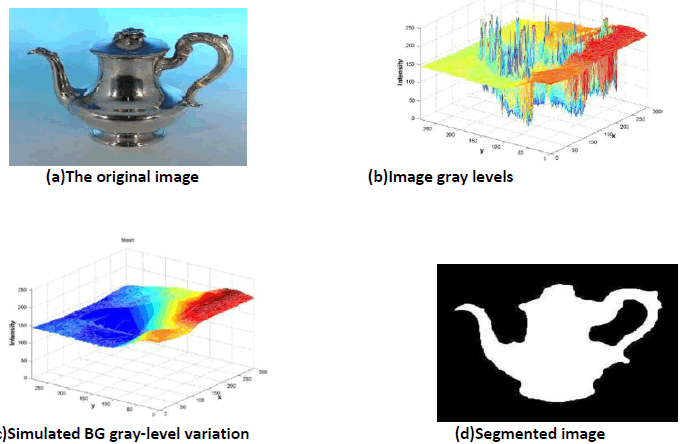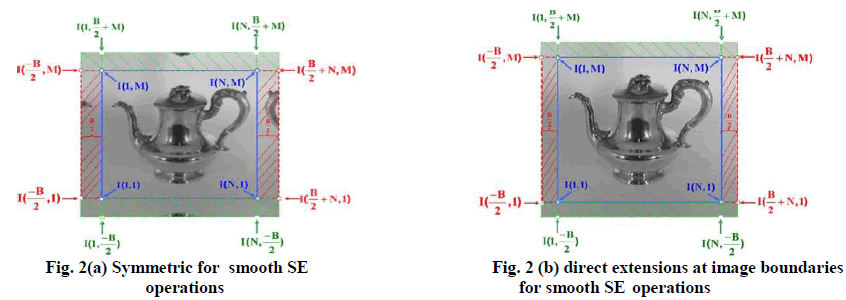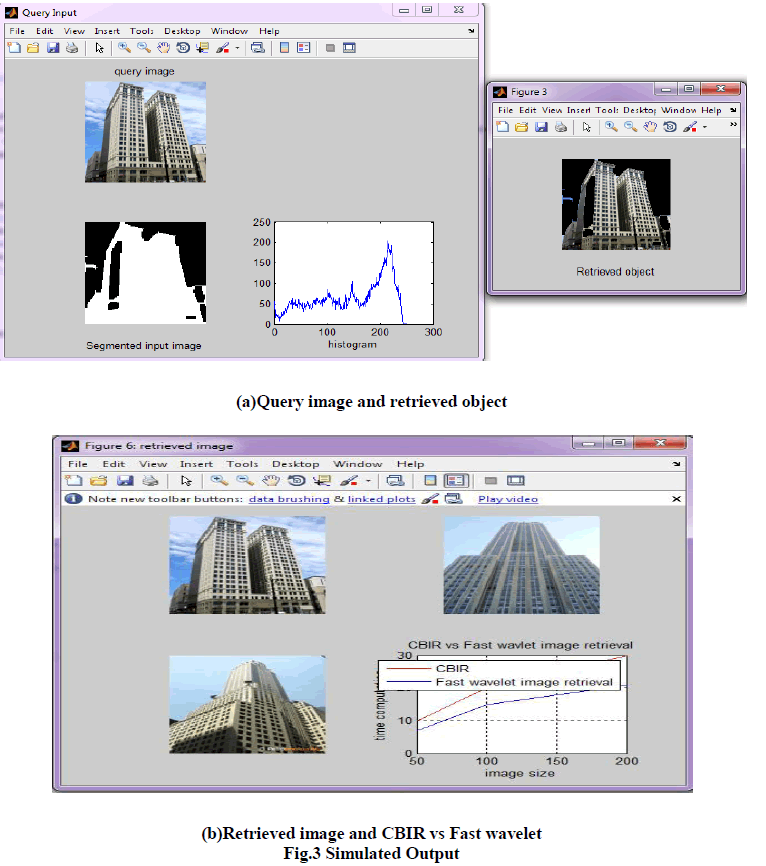ISSN ONLINE(2278-8875) PRINT (2320-3765)
ISSN ONLINE(2278-8875) PRINT (2320-3765)
Manimegalai.S1, Senthil.T2
|
| Related article at Pubmed, Scholar Google |
Visit for more related articles at International Journal of Advanced Research in Electrical, Electronics and Instrumentation Engineering
Segmentation refers to the process of partitioning a digital image into multiple segments. Image segmentation is typically used to locate objects and boundaries (lines, curves, etc.) in images. Processing images for specific targets on a large scale has to handle various kinds of contents with regular processing steps. To segment objects in one image, using the dual multiScalE Graylevel mOrphological open and close recoNstructions (SEGON) algorithm. It can be used to build a BackGround (BG) gray-level variation mesh, which is to identify BG and object regions. Content-Based Image Retrieval (CBIR) was carried out to evaluate the object segmentation capability in dealing with large-scale database images. CBIR is a technique which uses visual contents to search image from large scale database. The object segmentation method can be extended to extract other image features, and new feature types can be incorporated into the algorithm to further improve the image retrieval performance.
Keywords |
| Content-based image retrieval (CBIR), dual multiscale gray-level morphological reconstructions, object segmentation. |
INTRODUCTION |
| Content based similarity retrieval for multimedia data become important since international coding standards, such as the Joint Photographers Expert Group (JPEG), the Motion Pictures Expert Group 1 (MPEG-1), MPEG-2 and MPEG-4 started to be widely used and distributed over the Internet. When one considers the length and the detail of hand-coded similarity definitions, one could justly claim that “one image is worth than a thousand words”. The multimedia content description standard, i.e., MPEG-7, provides formal descriptors for different applications, such as archival, browsing, retrieval, etc. Similarity between two media objects can be evaluated by computing the distance between their numerical feature descriptors. These visual descriptors provide accurate similarity measurement by feature types, such as color, shape, and textures. However, the capability of MPEG-7 descriptors in measuring the similarity is limited to the description space. If the descriptors are not applied to the right feature content in images, improving the retrieval method alone will not yield accurate retrieved results. In other words, it is necessary to perform preprocessing on all database images before applying the descriptors. |
| The purpose of our research was to develop a robust image object segmentation algorithm with regular processing steps to deal with large-scale database images. Concerning visual signal processing and image segmentation is essential for various applications. It describes the process whereby each pixel in an image is labeled, such that pixels with the same label present coherent visual characteristics. |
| This allow for a semantic approach to image analysis. One way to perform image segmentation is to utilize the clustering algorithm in the color space domain i.e., HSV or RGB. Segmentation can also be based on the statistics of the color space description of the image, e.g., color histogram. These methods are carried out in the color space domain instead of the image pixel domain, whose results depend on the initial cluster setting. Edge-based segmentation is simple but it requires a further linking procedure to segment an image. Among color region-based approaches, the region-growing approach provides an initial set of seeds regions are then grown by comparing neighboring pixels, which are merged with the region with the closest mean color. JSEG seeks to divide an image into spatially continuous disjoint and homogenous regions based on the image. |
| The high and low values in the image correspond to possible boundaries and interiors of color/texture regions. It uses a region merging approach. Experiments show that JSEG provides satisfactory results on most color images. The watershed technique splits one image into regions based on its gray-level topology. Regions are split by watersheds, which are constructed from adjacent catchment basins. Multiscale morphological reconstruction is used to eliminate the over segmentation in the watershed algorithm. Graph-based segmentation takes the global image information and local spatial relationships into consideration to perform image segmentation. It defines a predicate to measure the boundary evidence between two neighbouring regions to yield a graph-based representation of one image. |
RELATED WORK |
| Processing images for specific targets on a large scale has to handle various kinds of contents with regular processing steps. To segment objects in one image, we utilized dual multiScalE Graylevel mOrphological open and close reconstructions(SEGON) to build a background(BG) gray-level variation mesh, which can help to identify BG and object regions CBIR was carried out to evaluate the object segmentation capability in dealing with large-scale database images. Content based image retrieval is a technique which uses visual contents to search image from large scale database[1]. |
| Segmentation was done by using generalized mixture modeling and feature selection. Spatial Information was not investigated. A clustering model that efficiently mitigates image and video under/over-segmentation by combining generalized Gaussian mixture modeling and feature selection. A new unsupervised color image segmentation algorithm, which exploits the information obtained from detecting edges in color images in the color space.The accuracy was not up to the level. Texture modeling is performed by color quantization and local entropy computation of the quantized image. The obtained texture and colour information along with a region growth map consisting of all fully grown regions are used to perform a unique multi resolution merging procedure to blend regions with similar characteristics[2]. |
| Unsupervised image segmentation is an important component in many image understanding algorithms and practical vision systems. However, evaluation of segmentation algorithms thus far has been largely subjective, leaving a system designer to judge the effectiveness of a technique based only on intuition and results in the form of a few example segmented images. This is largely due to image segmentation being an ill-defined problem and there is no unique ground-truth segmentation of an image against which the output of an algorithm may be compared[3]. |
| A method of segmenting gray level images using multi scale morphology. The approach resembles watershed algorithm in the sense that the dark (respectively bright) features which are basically canyons (respectively mountains) on the surface topography of the gray level image are gradually filled (respectively clipped) using multi scale morphological closing (respectively opening) by reconstruction with isotropic structuring element[4]. |
| The algorithm detects valid segments at each scale using three criteria namely growing, merging and saturation. Segments extracted at various scales are integrated in the final result.The basic computational module of the technique is an pattern recognition procedure, the mean shift. The relation of the mean shift procedure to the nadarayawatson estimator from kernel regression and the robust M-estimatorsof location is also established. Algorithms for two low-level vision tasks, discontinuity preserving smoothing and image segmentation, are described as applications. In these algorithms, the only user set parameter is the resolution of the analysis and either gray level are accepted as input[5]. |
PREPROCESSING |
| Image segmentation is essential for CBIR because it extracts necessary and significant information from images. In a regular CBIR system, the retrieval performance is affected by the image segmentation result. In general, features are extracted from the entire image, which means that trivial BG information can bias the feature and adversely affect the retrieval performance. To deal with database image segmentation, the CBIR system requires regular and efficient preprocessing and segmentation algorithms. The SEGON is used to roughly identify the background regions. A background gray-level variation mesh was constructed over these regions. |
| The design target is to segment the objects of database images by removing background with an unsupervised procedure. The segmented objects were then normalized with a minimum bounding circle to remove noises and to improve the accuracy of shape description. |
A. Morphological Operation |
| Morphological operations are performed in order to reduce spurious points or cluster area that may result in false core point detection. The purpose of this process is to smooth, fill in and/or remove objects in a binary image. This step will remove the small areas and thus create more compact cluster. This will help to make the searching process faster. |
| The identification of objects within an image can be a very difficult task. The techniques used on these binary images. Such techniques are blob analysis, connectivity analysis, and morphological image processing (from the Greek word morphe, meaning shape or form). The foundation of morphological processing is in the mathematically rigorous field of set theory however, this level of sophistication is seldom needed. |
 |
| Fig.1 Utilizing global gray-level variation of one image to segment objects |
| A bag of tricks is used rather than standard algorithms and formal mathematical properties. Four Basic morphological operations are used in processing of binary images. Such as Erosion, dilation, opening, closing. Opening is defined as an erosion followed by a dilation operation. Closing is a dilation followed by an erosion operation. |
B. Background Graylevel Variation |
| The normalized SE size B is represented as the ratio of the actual B size to the image by the width. For morphological Open by Reconstruction (Close by Reconstruction) to reconstruct the regions near object/BG boundaries, to process I and precisely locate the concave/convex gray-level variation regions of the object. However, it is possible that smaller SEs also satisfy the stability criteria. Adopting edge features I in and estimating the edge coverage rate by as a second stability criterion would help to make correct decisions on selecting proper SE sizes. |
| The multiscale morphological open (close) reconstruction, MSOR (MSCR), to determine the proper value that can help to segment convex (concave) gray-level regions for the object in one image.` |
 |
| Since grayscale OR (CR) operations with different SEs are confined inside the image boundary, they cannot pass through the image boundary cuts and lead to false object segmentation along image boundaries. As the SE size may be relatively large compared with that of the image, it would enlarge the area of false object/BG segmentation. |
IMAGE DESCRIPTORS |
| As far as image preprocessing is concerned, good retrieval performance could only be achieved when the key subject of the visual contents could be precisely specified before extracting feature descriptors. For example, the shape descriptors should be imposed on the shape of meaningful objects in a trademark pattern image instead of blind descriptions of the entire image. The color descriptors should be used to represent color features of the key objects instead of the mixed features that includes trivial BG information. |
A. Color Descriptor |
| The MPEG-7 image color descriptors include color layout color structure, and dominant color. Presenting images with the appropriate color space helps to extract color features with little data redundancy. The RGB color presentation is used in computer monitors. However, for image processing applications, RGB is not perceptually uniform equal distances in different regions or along different dimensions of the RGB space do not correspond to equal perception of color dissimilarity. |
| The color feature of one image is usually described by the color histogram, which is not affected by shift, rotation, translation and shape adjustment. |
B. Shape Descriptors |
| Shape descriptors are extracted from image contents according to different indexing applications. Both preprocessing steps are designed for the discrimination of different shapes or the identification of the same shapes. |
C. Texture Descriptor |
| The MPEG-7 comprises homogeneous and non homogeneous texture descriptors. For the former, the homogeneous texture descriptor (HTD) is designed to extract homogeneous texture from rectangle image regions. |
| To apply HTD on arbitrary shape regions, it needs to interpolate (extrapolate) to yield rectangle regions before extracting texture features to eliminate spurious frequency components. As it may comprise more than one arbitrary region shapes in the segmented image. |
PERFORMANCE EVALUATION |
| The performance of SEGON can be evaluated in two aspects, i.e., the object boundary accuracy of segmented image and its capability in dealing with the object segmentation of large-scale database images. |
A. Object Segmentation Accuracy |
| To subjectively evaluate image segmentation accuracy, a segmented image has to be compared against a manually labeled segmented image. This supervised evaluation approach requires user assistance and inherently restricts the assessment to a limited scope of segmentation comparisons over a predetermined set of images. |
B. Image Retrieval with Shape Descriptor |
| The SEGON control steps are simple and regular for segmenting database images with different object contents. Since geometric shape information and pixel color gray levels are available, it performs CBIR with features of shape, color or both to evaluate the retrieval performance with SEGON enabled. It successively selected one highly deterministic feature among query samples to output a robust global classifier. |
RESULTS AND DISCUSSIONS |
 |
| The simulated output shows the segmentation between foreground and background objects using content based image retrieval method. Future work includes object segmentation in video using the same SEGON algorithm. |
CONCLUSION AND FUTURE WORKS |
| A simple and regular image object segmentation method, i.e., SEGON, has been proposed to deal with large-scale image databases. It performs dual multiscale morphological reconstruction operations on the gray levels of entire images to identify the objects from a macroscopic perspective. With this global BG information, well-segmented regions belonging to the BG can be grasped as a whole by a constructed BG gray-level variation mesh, which enables SEGON to exploit the segmentation efficiency of established methods to refine segmentations. For CBIR applications that deal with large-scale database images, SEGON has helped in extracting accurate object color and shape features, such that multiple feature types can be used to perform retrieval, e.g., multiple instance query with multiple feature types (MIMF). |
ACKNOWLEDGMENT |
| The authors would like to thank ,Dr.Mrs.S.Nirmala, Head Of The Department, Department of Electronics and Communication Engineering, Muthayammal Engineering College, for her stimulating comments, which helped me in bringing things in my way.We also acknowledge the Professors who collaborated with us for the design. |
References |
|